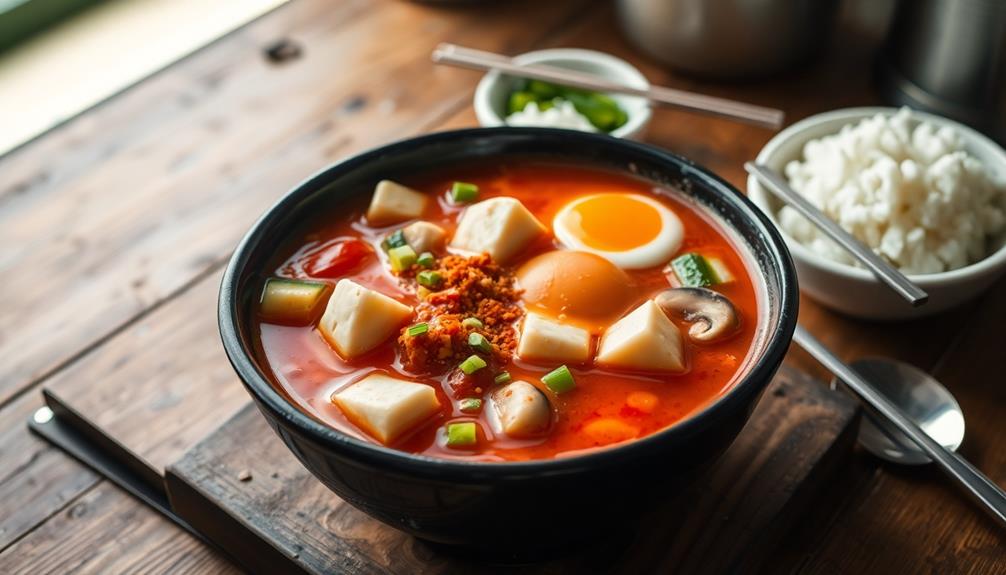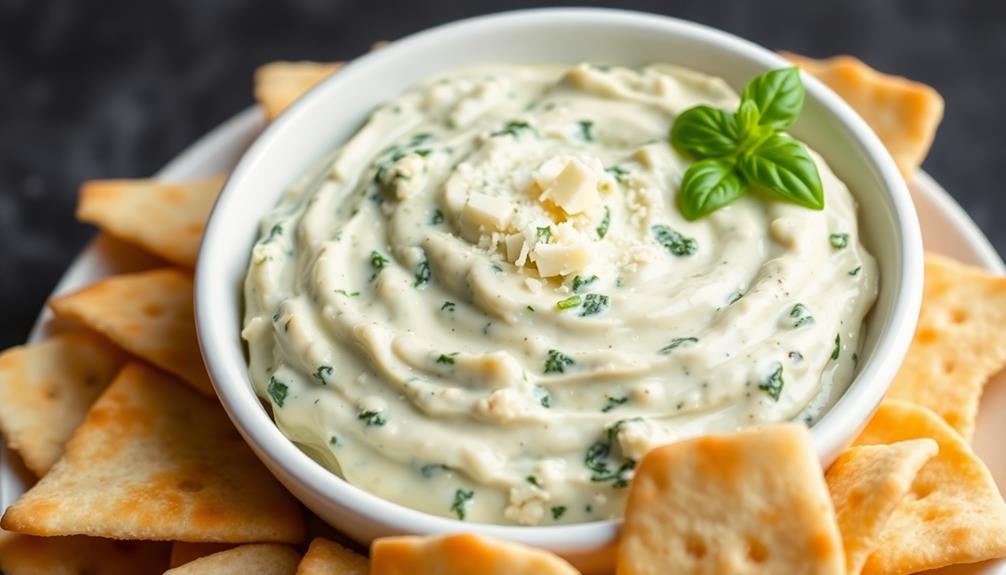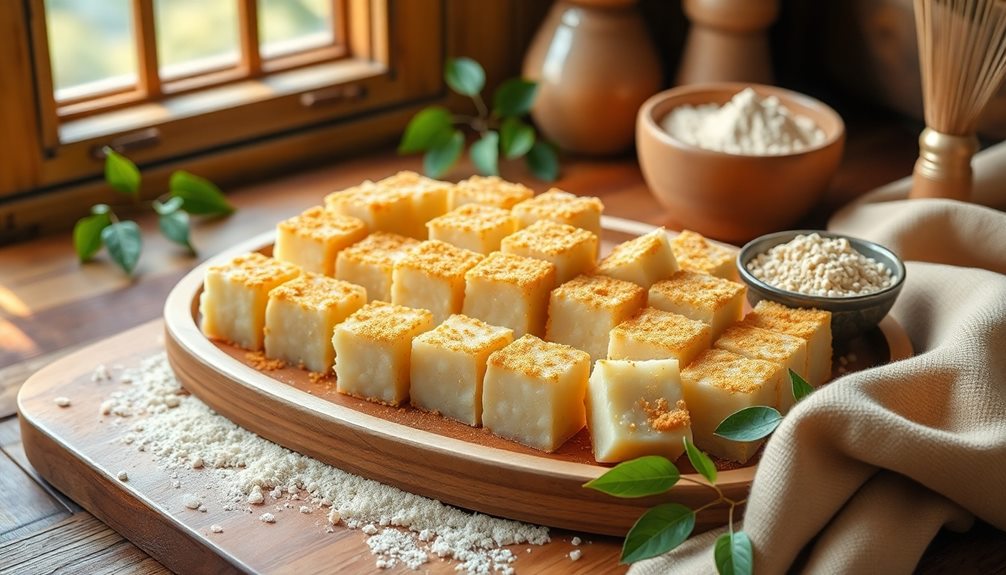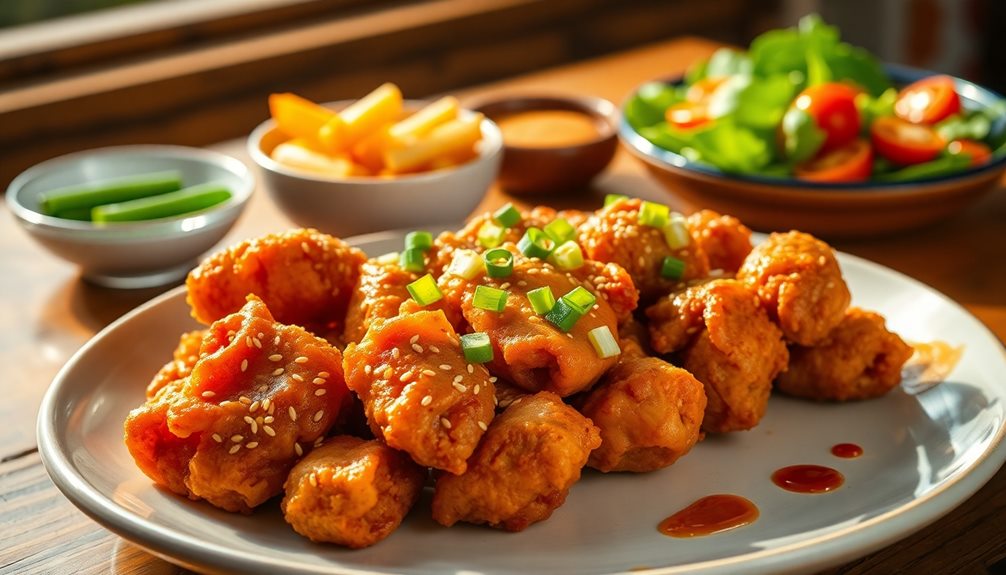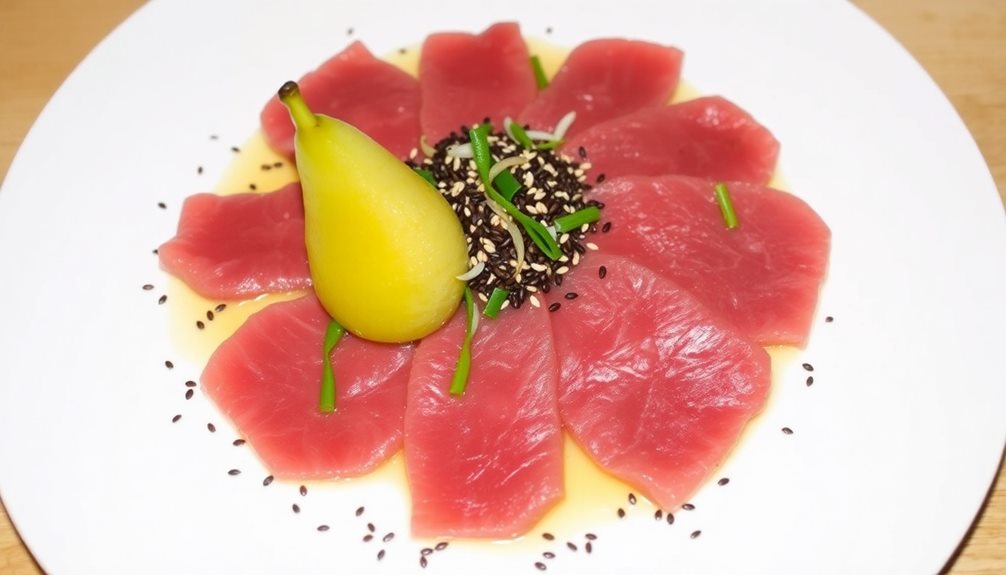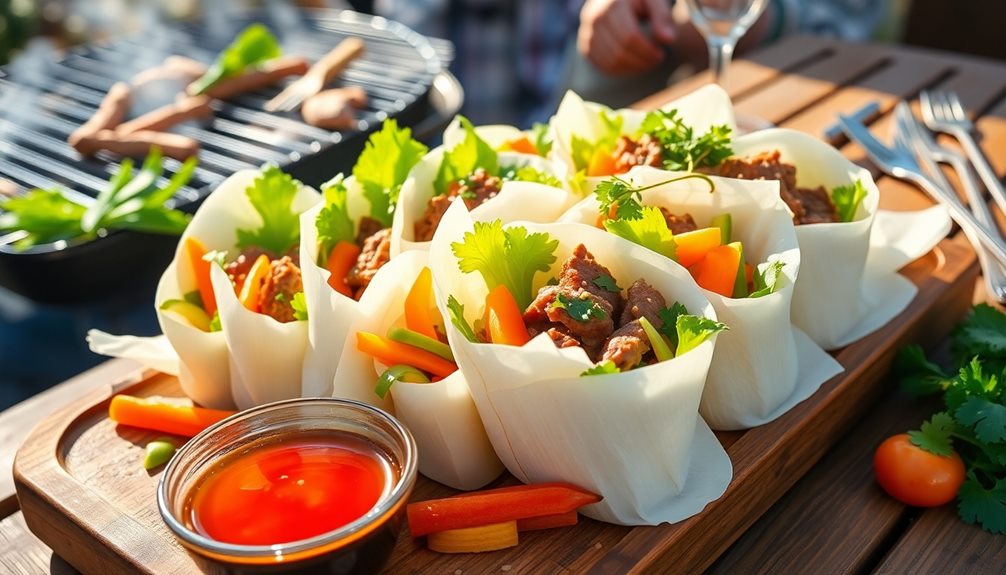Soondubu jjigae is a delightful soft tofu stew that warms you right up! Picture silky soft tofu swimming in a spicy, flavorful broth, mixed with fresh veggies, and maybe some yummy seafood or meat. It's super easy to make, too! You heat oil, sauté onions and mushrooms, and then add gochujang for some spice. Next, you gently introduce your tofu and enjoy the sizzling smell as it simmers. This dish is perfect for chilly days and served hot with rice! Doesn't that sound tasty? Stick around to discover more about this comforting dish and how to make it shine!
Key Takeaways
- Soondubu jjigae is a spicy soft tofu stew, traditionally enjoyed for warmth and sustenance during cold months.
- The dish features silky soft tofu, vegetables, and optional proteins like seafood or meat in a flavorful broth.
- Key ingredients include gochugaru, gochujang, garlic, and a variety of fresh vegetables for a rich taste.
- It is best served hot with steamed rice and kimchi, enhancing the overall meal experience.
- Soondubu jjigae can be customized to personal taste, making it a versatile dish for different dietary preferences.
History
Soondubu jjigae, a beloved Korean dish, has a rich history that dates back several centuries. This delicious stew made with soft tofu has roots in the Korean peninsula, where it's enjoyed by families and friends alike.
You mightn't know, but soondubu jjigae was originally a simple dish for farmers and laborers who needed something warm and filling after a long day of work.
As time went on, this hearty stew evolved, and people began adding more ingredients to make it even tastier. You can find various versions with seafood, vegetables, or even meat, showing how creative folks can get!
The dish became popular in homes and restaurants, bringing people together over steaming bowls of comfort.
In Korea, soondubu jjigae is often served with rice and side dishes, making it a complete meal. It's even a favorite during cold winter months, warming you up from the inside out.
Recipe
Soondubu Jjigae, also known as soft tofu stew, is a comforting Korean dish that's beloved for its rich flavors and nourishing qualities. This hearty stew features silky soft tofu, a variety of vegetables, and often includes seafood or meat, all simmered together in a spicy broth. Its warm, spicy nature makes it the perfect meal for cold days or when you're feeling under the weather. For those looking to recreate this classic Korean dish at home, there are numerous Soondubu Jjigae recipes available online. Whether you prefer a traditional version or a vegetarian twist, there are endless variations to suit every palate. Many sundubujjigae recipes also include tips for achieving the perfect balance of flavors and textures, ensuring that your homemade stew will be just as satisfying as any you’d find in a Korean restaurant.
The beauty of Soondubu Jjigae lies in its adaptability; you can easily customize it to suit your taste preferences or dietary restrictions.
To prepare Soondubu Jjigae, you'll need a few key ingredients that contribute to its signature flavor. The main star is the soft tofu, known as "soondubu," which gives the dish its creamy texture. The broth is typically seasoned with gochugaru (Korean chili flakes) and gochujang (Korean chili paste), providing a spicy kick. You can choose to include various proteins like seafood, pork, or even mushrooms for a vegetarian version.
Serve the stew hot with steamed rice and a side of kimchi for a complete meal.
Ingredients:
- 1 tub of soft tofu (soondubu)
- 1 tablespoon vegetable oil
- 1 small onion, sliced
- 2-3 cloves garlic, minced
- 1 medium zucchini, sliced
- 1 cup mushrooms, sliced (shiitake or button)
- 1-2 green onions, chopped
- 1 tablespoon gochugaru (Korean chili flakes)
- 1 tablespoon gochujang (Korean chili paste)
- 3 cups vegetable or chicken broth
- 1 cup seafood (optional: clams, shrimp, or fish) or 100g pork (optional)
- Salt and pepper to taste
- 1 egg (optional, for serving)
In a pot, heat the vegetable oil over medium heat. Sauté the sliced onion and minced garlic until fragrant and translucent. Add the zucchini and mushrooms, cooking until they soften.
Stir in the gochugaru and gochujang, allowing the spices to toast slightly. Pour in the broth and bring to a simmer. Gently add the soft tofu, breaking it into chunks, and if using, add your seafood or pork.
Let the stew simmer for about 10-15 minutes, allowing the flavors to meld. Just before serving, crack an egg into the simmering stew for added richness, and garnish with chopped green onions.
For the best Soondubu Jjigae experience, it's essential to adjust the spice levels to your liking. If you prefer a milder stew, reduce the amount of gochugaru and gochujang. Additionally, using homemade broth can elevate the flavors significantly.
This dish is best enjoyed fresh, but you can store leftovers in the refrigerator for a day or two. When reheating, add a splash of water to maintain the stew's consistency.
Cooking Steps
Now that you've got your ingredients ready, it's time to start cooking your delicious Soondubu Jjigae!
First, you'll prepare a tasty broth base, and then you'll mix in gochujang and garlic for that yummy flavor punch.
After that, you'll gently add soft tofu and your favorite veggies, letting everything simmer together before finishing it off with your choice of protein—sounds fun, right?
Step 1. Prepare the Broth Base
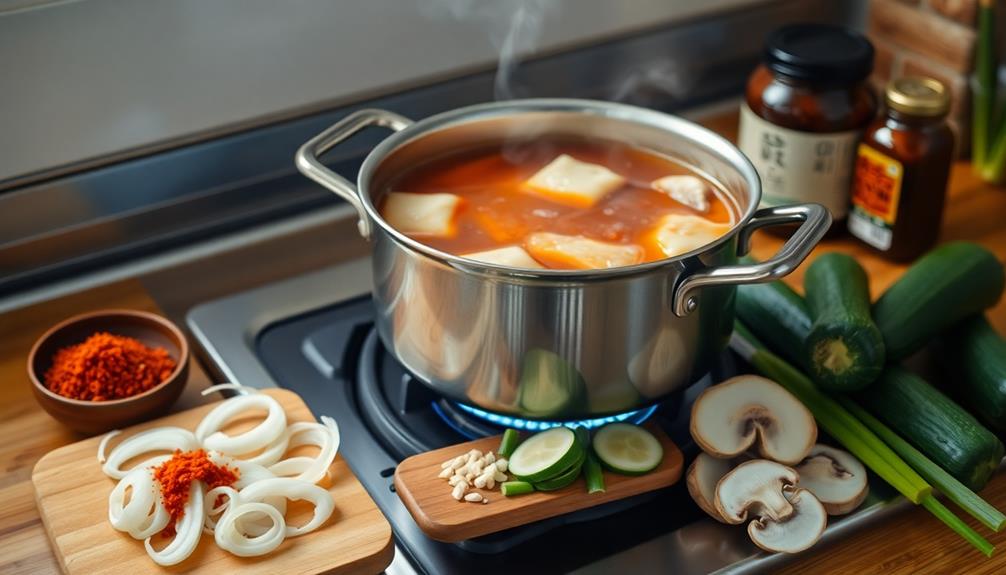
To create a rich and flavorful broth base for your soondubu jjigae, start by heating a pot over medium heat and adding a splash of vegetable or sesame oil.
Once the oil's nice and hot, toss in some chopped onions. You'll want to sauté them until they turn golden and fragrant—about five minutes should do the trick! This step is super important because it gives your broth that yummy, sweet onion flavor.
Next, grab some mushrooms—shiitake or button work great! Slice them up and add them to the pot. Stir them around for a few minutes until they soften. As the mushrooms cook, they'll soak up all that delicious onion goodness.
Now, let's not forget the water! Pour in about four cups, giving everything a good stir to combine. Bring the mixture to a gentle boil and then reduce the heat so it simmers.
This simmering will allow all the flavors to mingle and create a delightful broth base for your stew. Trust me, your kitchen will smell amazing! Keep it simmering for about 10 minutes, and you'll be ready to take the next flavorful step!
Step 2. Add Gochujang and Garlic
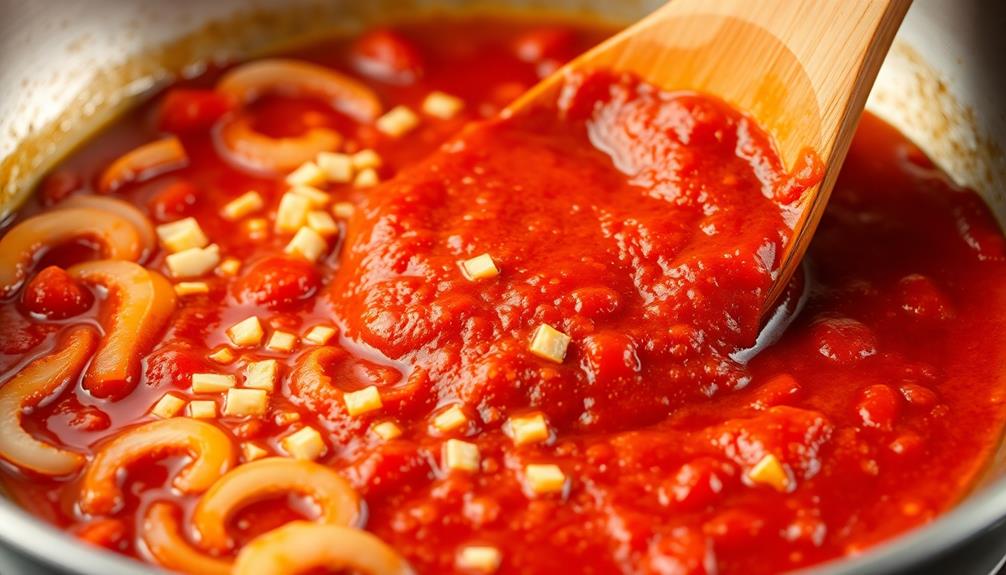
With the broth base simmering and the flavors developing beautifully, it's time to spice things up by adding gochujang and garlic.
First, grab your jar of gochujang, which is a red chili paste that brings a delightful kick to your stew. Scoop about two tablespoons and stir it into the broth. You'll notice the wonderful color change as it mixes in, making your stew look even more appetizing!
Next, let's not forget the garlic! Chop up three cloves of fresh garlic until they're nice and minced. If you can't smell the garlic yet, just wait! Toss it into the pot and stir everything together. As the garlic cooks, it'll release a warm, inviting aroma that'll make your mouth water.
Now, let your mixture simmer for a few more minutes. This is when the magic happens! The gochujang and garlic will infuse their flavors into the broth, creating a deliciously rich taste.
You can even give it a little taste test—just make sure it's not too hot! Your stew is on its way to being a cozy, flavorful dish that everyone will love.
Step 3. Incorporate Soft Tofu Gently
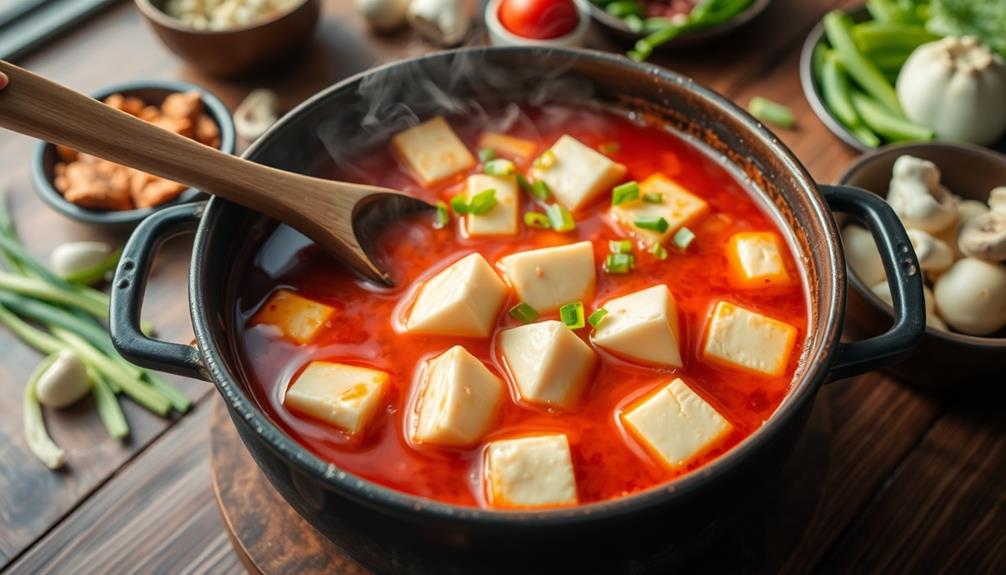
Once the broth is bubbling with flavor, gently incorporate the soft tofu.
You'll want to be careful here, as soft tofu is delicate and can break apart easily. Using a spoon, scoop out the tofu from its package and add it to your pot in big chunks.
Don't worry if they aren't perfect; the beauty of this dish is its homey feel!
Next, give the tofu a gentle nudge with your spoon, just enough to mix it into the broth without mashing it.
You'll see the tofu soaking up all those delicious flavors from the broth and spices. It's like a cozy hug for the tofu!
Let everything simmer together for about five minutes.
This allows the tofu to warm up and absorb even more tasty goodness. While it's cooking, you might notice the delicious smell wafting through your kitchen.
It's okay to drool a little; we won't judge!
Once that's done, you're one step closer to enjoying your soondubu jjigae.
Just remember, patience is key, and your gentle touch will make all the difference.
Get ready for a warm and comforting meal that'll make you smile!
Step 4. Add Vegetables and Simmer

After letting the tofu soak in all that rich flavor, it's time to bring in some vibrant vegetables. Start by chopping up your favorites like zucchini, mushrooms, and green onions. These won't only add color but also bring a delicious crunch to your stew.
Once they're ready, toss them into the pot with the simmering broth. Give everything a gentle stir, so the veggies mix in with that yummy sauce. Let it simmer for about 5 to 10 minutes, allowing the vegetables to soften and soak up all those fantastic flavors.
Keep an eye on them, so they don't turn mushy—nobody wants a stew that's a veggie mush party!
As the soup bubbles away, you'll notice how the aroma fills your kitchen, making everyone excited for dinner. If you like a little kick, you can sprinkle in some chili flakes or a dash of hot sauce. Just remember, keep it balanced; you want your stew to be tasty, not a fiery volcano!
Soon, you'll have a colorful, flavorful Soondubu Jjigae ready for the next step. Isn't cooking fun? Enjoy every moment!
Step 5. Add Protein of Choice
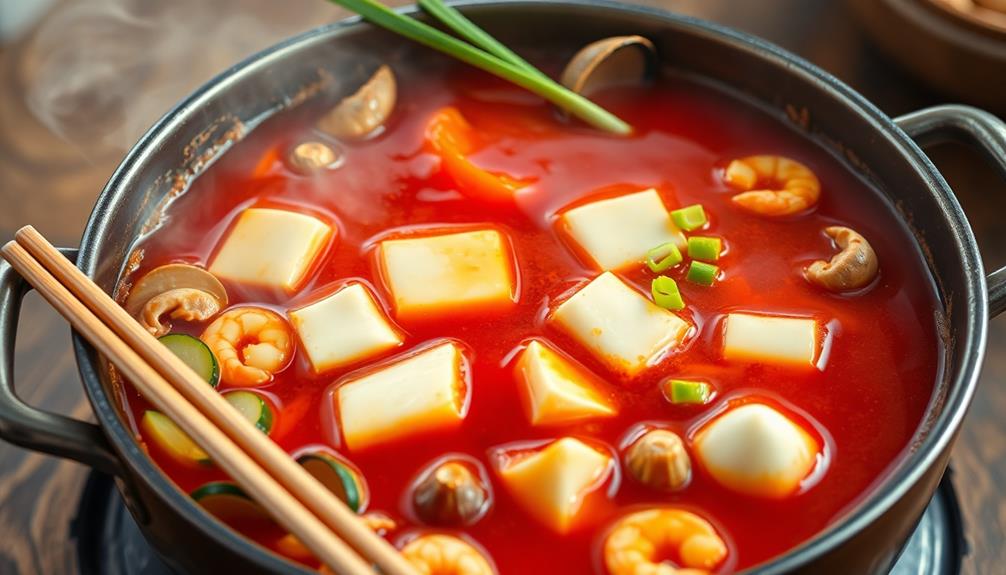
Now's the perfect time to add your protein of choice to the bubbling pot. You can use chicken, beef, shrimp, or even mushrooms if you want a vegetarian option.
If you're using meat, cut it into small bite-sized pieces so it cooks evenly and quickly. Toss it into the stew, and watch the magic happen! The protein will soak up all those delicious flavors from the spicy broth and mix beautifully with the soft tofu.
If you're going for shrimp, make sure they're peeled and deveined. They'll cook super fast, so you can add them last, just a few minutes before serving. Stir everything gently, making sure not to break up the tofu too much. It's like a cozy hug for your ingredients!
Give your stew a few more minutes to simmer, letting the protein cook through. You'll know it's ready when everything looks perfectly blended and smells amazing.
Final Thoughts
When it comes to savoring the rich, comforting flavors of soondubu jjigae, you'll find it's more than just a meal; it's an experience.
This delightful dish warms your heart and tummy, making it perfect for chilly days or when you need a little comfort. Picture yourself sitting at the table, steam rising from your bowl, while the spicy aroma beckons you to dig in. Yum!
Cooking soondubu jjigae at home isn't just fun; it lets you customize it just the way you like.
Want extra spice? Go for it! Prefer it milder? You can do that too. Adding your favorite protein makes it even tastier, and you can play around with different veggies.
Don't forget to enjoy it with a side of rice, which balances the flavors beautifully.
Plus, you can slurp up the broth with a big smile on your face!
Frequently Asked Questions
What Are the Health Benefits of Soondubu Jjigae?
You'll find that many dishes rich in nutrients offer health benefits, such as boosting immunity, improving digestion, and providing essential vitamins. Incorporating these foods into your diet can enhance overall wellness and vitality.
Can Soondubu Jjigae Be Made Vegetarian or Vegan?
Absolutely, you can make it vegetarian or vegan! Just substitute meat with vegetables, use vegetable broth instead of seafood or meat stock, and opt for plant-based seasonings. It'll still be delicious and satisfying!
What Are Common Side Dishes Served With Soondubu Jjigae?
When enjoying a meal, you'll often find common side dishes like kimchi, pickled vegetables, and rice. These add flavor and balance, enhancing the overall dining experience while complementing the main dish perfectly.
How Does Soondubu Jjigae Vary Regionally in Korea?
Regional variations in Korean cuisine often reflect local ingredients and preferences. You'll find spicier versions in the south, while northern areas might emphasize milder flavors. Each region's unique twist adds depth and character to traditional dishes.
What Is the Best Way to Store Leftover Soondubu Jjigae?
To store leftovers, let them cool down, then transfer to an airtight container. Refrigerate them for up to three days. When reheating, add a splash of water to maintain moisture and flavor. Enjoy!
